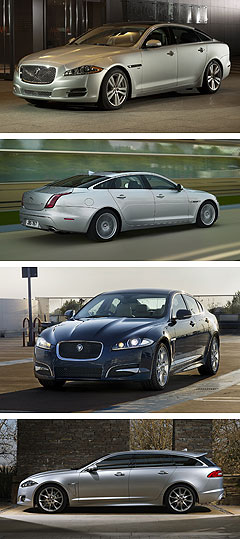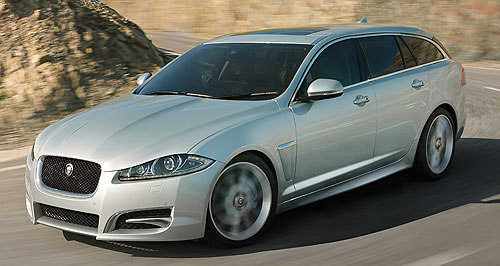Make / Model Search
Future models - Jaguar - XF - SportbrakeJaguar unveils changes for XF and XJTechnical treats: Standard eight-speed automatic transmissions and idle-stop yield fuel savings of up to 11 per cent on Jaguar’s MY13 XF and XJ. Sydney show reveal for more efficient MY13 Jaguar XF, XJ and new Sportbrake29 Jun 2012 UPDATED: 03/07/2012JAGUAR will introduce its updated 2013 model year XF sedan and XJ limousine to Australia at the Sydney show in October, when the new XF Sportbrake wagon will also become available here on a special order basis. The main MY13 changes are under the bonnet, where efficiency-improving measures including idle-stop and eight-speed automatic transmissions will become standard, resulting in fuel consumption reductions of up to 11 per cent. Jaguar’s new 250kW/450Nm 3.0-litre supercharged petrol engine will replace the naturally aspirated V6 and V8 engines, while a new 177kW/340Nm four-cylinder petrol engine will be introduced on the XF sedan. Inside, the infotainment and satellite-navigation systems have been upgraded to provide easier iPod track-list browsing, automatic map zooming when approaching junctions to make the intended route more obvious, and the option to program areas to avoid when calculating routes. In addition, the sound system becomes compatible with the DAB+ digital radio standard used in Australia and Jaguar Australia brand manager Kevin Goult told GoAuto the system will be introduced here first on the XJ and be made available later on the XF. Jaguar's updated sat-nav system can access traffic updates to inform the driver of congestion and map out an avoidance route, although Mr Goult said local compatibility is not yet available. Further improvements to the sat-nav include lane guidance and overhead sign information to help with negotiating confusing motorway junctions, but this feature is yet to be confirmed for Australia as it depends on whether Jaguar can get relevant updates from mapping provider Sensis.  From top: Model year 2013 Jaguar XJ XF XF Sportbrake. From top: Model year 2013 Jaguar XJ XF XF Sportbrake.Two premium Meridian sound systems will become available across more variants, one pumping out 380 watts through 11 speakers on the XF or 15 speakers on the XJ, while the other will provide 825W across 17 speakers (XF) and 20 speakers (XJ). Mr Goult told GoAuto full specifications and pricing for the MY13 XF and XJ will be announced at the Sydney show following a runout of the facelifted MY12 cars launched here last October. Mr Goult said the range reshuffle brought about by the new engines would result in “impressive” pricing, due to the strong Australian dollar and Jaguar’s local outfit being in favour with the factory for exceeding its volume targets – with sales up 26.4 to the end of May this year. “The UK is loving us at the minute,” he said. “The XF 2.2 diesel has driven a lot of that.” Jaguar’s new XF Sportbrake was unveiled at the Geneva show in March, with rear-end styling that shares the sedan's chrome bar cutting into the tail lights in similar fashion to the Hyundai i40. The Sportbrake is expected to be a niche product in Australia, hence its special order status and will be a diesel-only proposition from the factory as it is primarily aimed at the European market. UK Sportbrake pricing places it at a premium of around $3800 over the sedan – equivalent to almost eight per cent on the four-cylinder 2.2-litre diesel. Mr Goult said Jaguar Australia is working on setting the local Sportbrake premium at around seven per cent on the four-cylinder. The new supercharged petrol engine, which will replace both the 175kW/293Nm V6 petrol engine and 283kW/515Nm V8 in Australia, will leave Jaguar without a naturally aspirated engine in its XF or XJ line-ups. Both XF and short-wheelbase XJ fitted with the new unit – which will also appear in next year’s F-Type sportscar – can sprint from rest to 100km/h in a V8-matching 5.7 seconds and consume 9.4 litres of fuel per 100 kilometres on the EU combined cycle (compared with 10.5L/100km for the old V6 and 11.1L/100km for the V8). The 177kW/340Nm 2.0-litre four-cylinder that will become available on the XF in Australia is a Ford EcoBoost unit shared with the Range Rover Evoque and similarly re-engineered for rear-wheel-drive as the unit available in the Aussie Ford Falcon. Far less powerful but not much more efficient than the supercharged V6, it misses out on idle-stop technology, resulting in fuel consumption of 8.9L/100km. Unfortunately for Jaguar, that figure is significantly higher than the mid-six figures achieved by the similarly powerful BMW 528i and Mercedes-Benz E250, and it also misses out on the luxury car tax break for fuel-efficient vehicles. Engine management refinements on the 2.2-litre four-cylinder diesel introduced to Australia last October result in a drop in fuel consumption from 5.4L/100km to 5.1L/100km on both sedan and Sportbrake when running on 17-inch wheels. Fuel consumption on the 3.0-litre V6 twin-turbo diesel also improves, from 6.3L/100km to 6.0L/100km, while the Sportbrake consumes 6.2L/100km. Topping the fuel-efficiency improvements is the 5.0-litre supercharged V8, on which consumption has been slashed 11 per cent to 11.3L/100km on both XF and short-wheelbase XJ.  Read more25th of April 2012  New Jaguar engines with benefitsFour-cylinder turbo and supercharged V6 petrol engines to join Jaguar fleetAll future models Alfa Romeo Alfa Romeo Abarth Abarth Alpine Alpine Alpina Alpina Audi Audi Aston Martin Aston Martin BMW BMW Bentley Bentley Chery Chery Brabham Brabham Chrysler Chrysler Chevrolet Chevrolet Cupra Cupra Citroen Citroen DS DS Dodge Dodge Fiat Fiat Ferrari Ferrari Foton Foton Ford Ford Great Wall Great Wall FPV FPV Haval Haval GWM GWM Honda Honda Holden Holden Hummer Hummer HSV HSV Infiniti Infiniti Hyundai Hyundai Jaguar Jaguar Isuzu Isuzu Kia Kia Jeep Jeep Land Rover Land Rover Lamborghini Lamborghini Lexus Lexus LDV LDV Mahindra Mahindra Lotus Lotus Mazda Mazda Maserati Maserati Mercedes-AMG Mercedes-AMG McLaren McLaren MG MG Mercedes-Benz Mercedes-Benz Mitsubishi Mitsubishi Mini Mini Opel Opel Nissan Nissan Peugeot Peugeot Pagani Pagani Proton Proton Porsche Porsche Renault Renault Ram Ram Rover Rover Rolls-Royce Rolls-Royce Skoda Skoda Saab Saab SsangYong SsangYong Smart Smart Suzuki Suzuki Subaru Subaru Toyota Toyota Tesla Tesla Volvo VolvoXF pricing
Motor industry news |
Click to shareJaguar modelsResearch Jaguar All future models Alfa Romeo Alfa Romeo Abarth Abarth Alpine Alpine Alpina Alpina Audi Audi Aston Martin Aston Martin BMW BMW Bentley Bentley Chery Chery Brabham Brabham Chrysler Chrysler Chevrolet Chevrolet Cupra Cupra Citroen Citroen DS DS Dodge Dodge Fiat Fiat Ferrari Ferrari Foton Foton Ford Ford Great Wall Great Wall FPV FPV Haval Haval GWM GWM Honda Honda Holden Holden Hummer Hummer HSV HSV Infiniti Infiniti Hyundai Hyundai Jaguar Jaguar Isuzu Isuzu Kia Kia Jeep Jeep Land Rover Land Rover Lamborghini Lamborghini Lexus Lexus LDV LDV Mahindra Mahindra Lotus Lotus Mazda Mazda Maserati Maserati Mercedes-AMG Mercedes-AMG McLaren McLaren MG MG Mercedes-Benz Mercedes-Benz Mitsubishi Mitsubishi Mini Mini Opel Opel Nissan Nissan Peugeot Peugeot Pagani Pagani Proton Proton Porsche Porsche Renault Renault Ram Ram Rover Rover Rolls-Royce Rolls-Royce Skoda Skoda Saab Saab SsangYong SsangYong Smart Smart Suzuki Suzuki Subaru Subaru Toyota Toyota Tesla Tesla Volvo VolvoXF pricing
Motor industry news |











Facebook Twitter Instagram